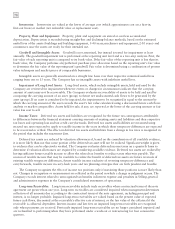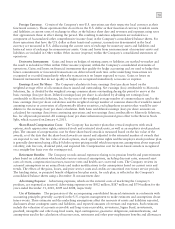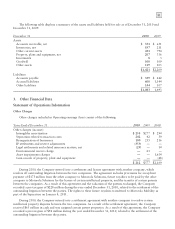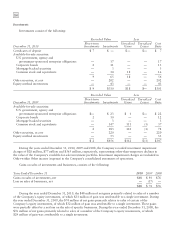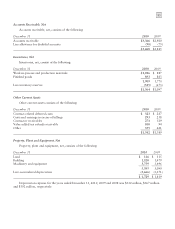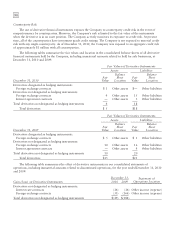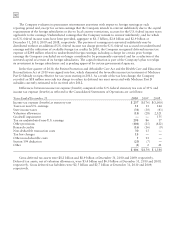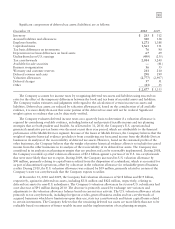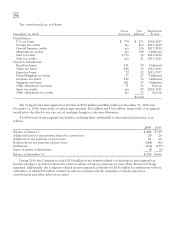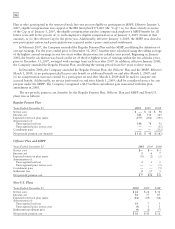Motorola 2010 Annual Report Download - page 96
Download and view the complete annual report
Please find page 96 of the 2010 Motorola annual report below. You can navigate through the pages in the report by either clicking on the pages listed below, or by using the keyword search tool below to find specific information within the annual report.
88
July 3, 2010. The $500 million of long-term debt repurchased included principal amounts of: (i) $65 million of the
$379 million then outstanding of the 6.50% Debentures due 2025 (the “2025 Debentures”), (ii) $75 million of the
$286 million then outstanding of the 6.50% Debentures due 2028 (the “2028 Debentures”), (iii) $222 million of the
$446 million then outstanding of the 6.625% Senior Notes due 2037 (the “2037 Senior Notes”), and
(iv) $138 million of the $252 million then outstanding of the 5.22% Debentures due 2097. After accelerating the
amortization of debt issuance costs and debt discounts, the Company recognized a loss of approximately $12 million
related to this debt tender in Other within Other income (expense) in the consolidated statements of operations.
During the year ended December 31, 2009, the Company repurchased $199 million of its outstanding long-
term debt for an aggregate purchase price of $133 million, including $4 million of accrued interest, all of which
occurred during the three months ended April 4, 2009. The $199 million of long-term debt repurchased included
principal amounts of: (i) $11 million of the $358 million then outstanding of the 7.50% Debentures due 2025,
(ii) $20 million of the $399 million then outstanding 2025 Debentures, (iii) $14 million of the $299 million then
outstanding 2028 Debentures, and (iv) $154 million of the $600 million then outstanding 2037 Senior Notes. The
Company recognized a gain of approximately $67 million related to these open market purchases in Other within
Other income (expense) in the consolidated statements of operations.
Aggregate requirements for long-term debt maturities during the next five years are as follows: 2011—
$605 million; 2012—$405 million; 2013—$5 million; 2014—$4 million; and 2015—$4 million.
Credit Facilities
The Company had a domestic syndicated revolving credit facility (as amended from time to time, the “Credit
Facility”), scheduled to mature in December 2011. The size of the Credit Facility was the lesser of: (1) $1.5 billion,
or (2) an amount determined based on eligible domestic accounts receivable and inventory. If the Company elected
to borrow under the Credit Facility, only then and not before, it would be required to pledge its domestic accounts
receivables and, at its option, domestic inventory. The Credit Facility did not require the Company to meet any
financial covenants unless remaining availability under the Credit Facility was less than $225 million. As of and
during the year ended December 31, 2010, there were no outstanding borrowings under this Credit Facility.
At December 31, 2010, the commitment fee assessed against the daily average unused amount was 75 basis
points.
On January 4, 2011, the Company terminated the Credit Facility and entered into a new $1.5 billion unsecured
syndicated revolving credit facility (the “2011 Motorola Solutions Credit Agreement”) that is scheduled to expire on
June 30, 2014. The 2011 Motorola Solutions Credit Agreement includes a provision pursuant to which the
Company can increase the aggregate credit facility size up to a maximum of $2.0 billion by adding lenders or having
existing lenders increase their commitments. The Company must comply with certain customary covenants,
including maintaining maximum leverage and minimum interest coverage ratios as defined in the 2011 Motorola
Solutions Credit Agreement. The Company has no outstanding borrowings under the 2011 Motorola Solutions
Credit Agreement.
5. Risk Management
Derivative Financial Instruments
Foreign Currency Risk
The Company uses financial instruments to reduce its overall exposure to the effects of currency fluctuations on
cash flows. The Company’s policy prohibits speculation in financial instruments for profit on exchange rate price
fluctuations, trading in currencies for which there are no underlying exposures, or entering into transactions for any
currency to intentionally increase the underlying exposure. Instruments that are designated as part of a hedging
relationship must be effective at reducing the risk associated with the exposure being hedged and are designated as
part of a hedging relationship at the inception of the contract. Accordingly, changes in the market values of hedge
instruments must be highly correlated with changes in market values of the underlying hedged items both at the
inception of the hedge and over the life of the hedge contract.
The Company’s strategy related to foreign exchange exposure management is to offset the gains or losses on the
financial instruments against losses or gains on the underlying operational cash flows or investments based on the
operating business units’ assessment of risk. The Company enters into derivative contracts for some of the


